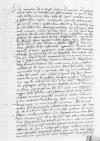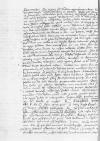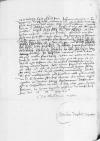Ex ⌊Monoeco⌋ ad te ⌊⌋ dubium esse, quorsum nam proficisceremur, rectane ms. recta ne(!)
⌈rectanerectane ms. recta ne(!)
⌉ ⌊Vercellas⌋ per ⌊Pedemontanos⌋, an ⌊Genuam⌋. Discussa tandem re omni satius visum est ⌊Genuam⌋ contendere, primo quod ⌊Pedemontani⌋ crebris incursionibus ⌊Gallorum⌋ subicerentur orig. subiicerentur⌈subicerentursubicerentur orig. subiicerentur⌉, ipsi non omnino animo a Gallis alieno, deinde quod ⌊dux Sabaudiae⌋ cum suo nomine foedus cum ⌊Franco rege⌋ contrahere non ausus fuerit, ⌊filium natu maiorem⌋ nondum, ut audio, trimum, cum filia Franci regis[1] copularit, adeo firmatis condicionibus orig. conditionibus⌈condicionibuscondicionibus orig. conditionibus⌉, ut iam in stipendium annuum praefinita orig. prefinita⌈praefinitapraefinita orig. prefinita⌉ illi cohors centum equitum catafractorum orig. cataphrattorum⌈catafractorumcatafractorum orig. cataphrattorum⌉ more Gallico sit, adiuncto ordine equestris militiae Gallicae. Talia adeo haec orig. hec⌈haechaec orig. hec⌉ tempora, ut cunae iam nobis milites et praefectos orig. prefectos⌈praefectospraefectos orig. prefectos⌉ plures superinscribed in place of crossed-out magis⌈magis plures plures superinscribed in place of crossed-out magis⌉ quam tentoria alant. Accessit ad haec impedimenta opportunus adventus trium triremium et unius myoparonis, quam classem
ill(ustris) or ill(ustrissimus)⌈ill(ustris)ill(ustris) or ill(ustrissimus)⌉
⌊Antoniotus Adurnus⌋ Genuensium dux ad nos excipiendos transmiserat. Dudum enim abierant duo illi myoparones, qui nos ex navi magna, quae in ⌊Corsicam⌋ contendebat, ⌊Monoecum⌋ advexerant. Ubi primum itaque advenere triremes illae, nulla mora facta confestim conscendimus 1527-06-21⌊die huius mensis Iunii XXI-o1527-06-21⌋ sub noctem usique
cf. Adagia 318 remis velisque ⌊remis et veliscf. Adagia 318 remis velisque ⌋, ut est in proverbio, alto nos mari credidimus medio fere canali inter ⌊Corsicam⌋ et ⌊Liguriam⌋ idque ideo, quod ⌊Franci⌋ litora orig. littora⌈litoralitora orig. littora⌉ omnia Liguriae et praesertim orig. presertim⌈praesertimpraesertim orig. presertim⌉ ⌊Savonam⌋ occupant.
Navigavimus ergo et nocte illa diei 1527-06-21⌊XXI-i1527-06-21⌋ et die 1527-06-22⌊XXII-o toto1527-06-22⌋, 1527-06-23⌊XXIII-o1527-06-23⌋ autem, quae vigilia est divi 1527-06-24⌊Ioannis Babtistae1527-06-24⌋, sub hora diei orientis sextam, quae est apud nos fere XI-a, nescio qua negligentia, magna sane, sed eam nobis pepererat terrae amicae iam pridem conspectae vicinitas, prius fere in Gallicam classem incidimus, quam eam conspiceremuus written over r⌈ru(!)sus written over r⌉. Subito itaque ⌊Galli⌋ remis, quam maxime poterant, inniti nos omni ex parte circumdare. Alii a, ne in ⌊Portum Finum⌋ perveniremus, a fronte nobis occurrere, alii a puppe, alii a lateribus. Erant autem in ea classe ⌊Gallorum⌋ triremes sedecim aut sane quindecim cum bergantino uno, nam sedecim vela numeravimus. Sed, ut fieri solet, aliae orig. alie⌈aliaealiae orig. alie⌉ aliis celeritate praestabant. Itaque primum duae velocissimae triremes nobis occurrere a latere, cumque nobis vicinitas periculi vires geminaret, vi effecimus, ut non a latere, sed a puppi irruerent. Quae res nobis securiorem remigationem peperit, cum minus iam ictibus bombardarum, qui multi erant et frequentes, remiges nostri  UUB, H. 154, f. 9v subicerentur orig. subiicerentur⌈subicerentursubicerentur orig. subiicerentur⌉, aliae interea, sed tardius, appropinquabant. Nos perpetuo cursu contendebamus in ⌊Portum Finum⌋, qui ditionis est ⌊Genuensium⌋ occidentalior ⌊Portu Veneris⌋, orientalior autem quam ⌊Genua⌋ milibus passuum viginti. Distabamus autem a dicto ⌊Portu Fino⌋, cum primum in conspectum Gallicae classis venimus, ad miliaria Italica quadraginta. Quid multa? Iam et remigibus nostris vires, et magnae parti nostrum animi defecerant. Ipse ⌊cancellarius⌋ lecto incumbebat vexatus podagra. Cumque alii super alios res perditas denuntiarent, ille inducere in animum id non poterat, mihi sane numquam fiducia defuit. Erant, qui me intuerentur tamquam orig. tanquam⌈tamquamtamquam orig. tanquam⌉ meo ductu meisque auspiciis in ea pericula devenissent. Sed Deus nobis auxilio fuit. Nam, cum crebro in nos bo<mb>ardae hostiles intonarent globique ferrei magni ponderis, nam inventi written over um⌈umii written over um⌉ sunt, qui 55 libras ferri ponderabant, nemo tamen ex nostris interiit, septem solum remi fracti atque ex horum fragmentis remiges duo vulnerati. Idem fere in aliis duabus triremibus evenit. Hostes desperata iam victoria abiectoque animo triremibus potiundi, conversis in bergantinum viribus, eundem videntibus nobis cepere. Fuere in eo homines 30, nemo tamen familiarium nostrorum. Tandem cum ⌊Portui Fino⌋ appropinquaremus, ab insequendo destitere veriti machinas, quae in arce et promontorio ad praesidium orig. presidium⌈praesidiumpraesidium orig. presidium⌉ tutelamque locatae fuere. Hunc exitum habuit proelium orig. prelium⌈proeliumproelium orig. prelium⌉ nostrum, quod septem horis nos tenuit. Poterant haec ⌊Genuae⌋ ab arce conspici. Ideoque sex aliae triremes paratae sunt, quae postridie eius diei nobis ⌊Genuam⌋ properantibus occurrere videntibus ⌊Gallis⌋, qui altum tenebant, cum nos litus orig. littus⌈lituslitus orig. littus⌉ illud, quod totum amicum est, raderemus magnaque pompa excepti sumus a civitate universa. Vide ergo sortem nostram. Multi optime ominantur. Me id solum male habet, quod inter ignotos versor.
UUB, H. 154, f. 9v subicerentur orig. subiicerentur⌈subicerentursubicerentur orig. subiicerentur⌉, aliae interea, sed tardius, appropinquabant. Nos perpetuo cursu contendebamus in ⌊Portum Finum⌋, qui ditionis est ⌊Genuensium⌋ occidentalior ⌊Portu Veneris⌋, orientalior autem quam ⌊Genua⌋ milibus passuum viginti. Distabamus autem a dicto ⌊Portu Fino⌋, cum primum in conspectum Gallicae classis venimus, ad miliaria Italica quadraginta. Quid multa? Iam et remigibus nostris vires, et magnae parti nostrum animi defecerant. Ipse ⌊cancellarius⌋ lecto incumbebat vexatus podagra. Cumque alii super alios res perditas denuntiarent, ille inducere in animum id non poterat, mihi sane numquam fiducia defuit. Erant, qui me intuerentur tamquam orig. tanquam⌈tamquamtamquam orig. tanquam⌉ meo ductu meisque auspiciis in ea pericula devenissent. Sed Deus nobis auxilio fuit. Nam, cum crebro in nos bo<mb>ardae hostiles intonarent globique ferrei magni ponderis, nam inventi written over um⌈umii written over um⌉ sunt, qui 55 libras ferri ponderabant, nemo tamen ex nostris interiit, septem solum remi fracti atque ex horum fragmentis remiges duo vulnerati. Idem fere in aliis duabus triremibus evenit. Hostes desperata iam victoria abiectoque animo triremibus potiundi, conversis in bergantinum viribus, eundem videntibus nobis cepere. Fuere in eo homines 30, nemo tamen familiarium nostrorum. Tandem cum ⌊Portui Fino⌋ appropinquaremus, ab insequendo destitere veriti machinas, quae in arce et promontorio ad praesidium orig. presidium⌈praesidiumpraesidium orig. presidium⌉ tutelamque locatae fuere. Hunc exitum habuit proelium orig. prelium⌈proeliumproelium orig. prelium⌉ nostrum, quod septem horis nos tenuit. Poterant haec ⌊Genuae⌋ ab arce conspici. Ideoque sex aliae triremes paratae sunt, quae postridie eius diei nobis ⌊Genuam⌋ properantibus occurrere videntibus ⌊Gallis⌋, qui altum tenebant, cum nos litus orig. littus⌈lituslitus orig. littus⌉ illud, quod totum amicum est, raderemus magnaque pompa excepti sumus a civitate universa. Vide ergo sortem nostram. Multi optime ominantur. Me id solum male habet, quod inter ignotos versor.
Hic omnia dubia et intranquilla. Ingens adhaec penuria annonae. Italia tota caesarem odit. Cancellarius mandatum exspectat a caesare. Exercitus caesaris encrypted ⌈⌊Italia⌋[2] tota ⌊caesarem⌋[3] odit. ⌊Cancellarius⌋[4] mandatum exspectat orig. expectat⌈exspectatexspectat orig. expectat⌉ a[5] ⌊caesare⌋.[6] Exercitus ⌊caesaris⌋[7]Italia tota caesarem odit. Cancellarius mandatum exspectat a caesare. Exercitus caesaris encrypted ⌉[8] adhuc est, ubi prius. Vicerex encrypted ⌈⌊Vicerex⌋Vicerex encrypted ⌉[9] ubique male audit. Rex Angliae encrypted ⌈male audit. ⌊Rex Angliae⌋male audit. Rex Angliae encrypted ⌉[10] dicitur parare exercitum. Cancellarius encrypted ⌈parare ms. pararae(!)
⌈parareparare ms. pararae(!)
⌉ exercitum. Cancellariusparare exercitum. Cancellarius encrypted ⌉,[11] ut satis intellexi, vellet Franciscum Sportiam restitui encrypted ⌈vellet ⌊Franciscum Sportiam⌋ restituivellet Franciscum Sportiam restitui encrypted ⌉,[12] sed nescio, quid fiet, non admodum mihi videtur fieri posse. Nihil tamen possumus scire, quid futurum sit, priusquam litteras habeamus a ⌊caesare⌋. Ab his enim res omnes nostrae dependent. Interim ⌊Genuae⌋ manebimus. De pontifice(?) encrypted ⌈pontifice(?)pontifice(?) encrypted ⌉[13] puto satis rem omnem te intellexisse. ⌊Antonius de Leyua⌋ praefectus ⌊Mediolani,⌋[14] ubi primum audivit ⌊cancellarium⌋ applicuisse ⌊Monoecum⌋, missis cohortibus denis, comitatus ⌊Satyra
 UUB, H. 154, f. 11r
nae⌋ et ⌊Valentiae⌋,[15] si quid residuum furor Hispanicus reliquerat, iterum depopulari diripique iussit, arbitratus, ut reor, non ex voluntate ⌊caesaris⌋ bonum hunc ⌊senem⌋ abiisse. Haec merces laborum. Cuperem scire, an vicerex encrypted ⌈⌊vicerex⌋vicerex encrypted ⌉[16] reddiderit vobis statum Barensem encrypted ⌈⌊statum Barensem⌋statum Barensem encrypted ⌉.[17] Scripsit is nuper per secretarium quendam orig. quemdam⌈quendamquendam orig. quemdam⌉ bonum esse, quod cancellarius
huc veniret encrypted ⌈bonum esse, quo ms. m(!)
⌈oo ms. m(!)
⌉d ⌊cancellarius⌋[18]
huc veniretbonum esse, quod cancellarius
huc veniret encrypted ⌉.[19] Multa animo molimur, nescio quo successu. Plurimum aveo scire, si quid novi sit de illustrissimo ⌊rege Daniae⌋ deque Norvegica expeditione. Nescio etiam, an ⌊Melchior⌋ tuto redierit domum. Cons[ilium] de ducatu Mediolani encrypted ⌈Consilium paper damaged⌈[ilium]ilium paper damaged⌉ de ducatu ⌊Mediolani⌋Cons[ilium] de ducatu Mediolani encrypted ⌉[20]
est, q(uod) idem aut proveniet regi Bohemiae, aut differetur adhuc eius donatio ad tempus encrypted ⌈⌊regi Bohemiae⌋,[21] aut differetur adh ms. b(!)
⌈hh ms. b(!)
⌉uc eius donatio ad tempusregi Bohemiae, aut differetur adhuc eius donatio ad tempus encrypted ⌉.[22] Interea simulabitur tractatus iustitiae futurus in rem Francisci Sphanciciportie encrypted ⌈tractatus iustitiae orig. iusticie⌈iustitiaeiustitiae orig. iusticie⌉ futurus in rem ⌊Francisci Sphanciciportie⌋tractatus iustitiae futurus in rem Francisci Sphanciciportie encrypted ⌉.[23] Ita cancellarius encrypted ⌈⌊cancellarius⌋cancellarius encrypted ⌉[24] mihi narravit. Non dubito autem, quin miranda simus visuri.
UUB, H. 154, f. 11r
nae⌋ et ⌊Valentiae⌋,[15] si quid residuum furor Hispanicus reliquerat, iterum depopulari diripique iussit, arbitratus, ut reor, non ex voluntate ⌊caesaris⌋ bonum hunc ⌊senem⌋ abiisse. Haec merces laborum. Cuperem scire, an vicerex encrypted ⌈⌊vicerex⌋vicerex encrypted ⌉[16] reddiderit vobis statum Barensem encrypted ⌈⌊statum Barensem⌋statum Barensem encrypted ⌉.[17] Scripsit is nuper per secretarium quendam orig. quemdam⌈quendamquendam orig. quemdam⌉ bonum esse, quod cancellarius
huc veniret encrypted ⌈bonum esse, quo ms. m(!)
⌈oo ms. m(!)
⌉d ⌊cancellarius⌋[18]
huc veniretbonum esse, quod cancellarius
huc veniret encrypted ⌉.[19] Multa animo molimur, nescio quo successu. Plurimum aveo scire, si quid novi sit de illustrissimo ⌊rege Daniae⌋ deque Norvegica expeditione. Nescio etiam, an ⌊Melchior⌋ tuto redierit domum. Cons[ilium] de ducatu Mediolani encrypted ⌈Consilium paper damaged⌈[ilium]ilium paper damaged⌉ de ducatu ⌊Mediolani⌋Cons[ilium] de ducatu Mediolani encrypted ⌉[20]
est, q(uod) idem aut proveniet regi Bohemiae, aut differetur adhuc eius donatio ad tempus encrypted ⌈⌊regi Bohemiae⌋,[21] aut differetur adh ms. b(!)
⌈hh ms. b(!)
⌉uc eius donatio ad tempusregi Bohemiae, aut differetur adhuc eius donatio ad tempus encrypted ⌉.[22] Interea simulabitur tractatus iustitiae futurus in rem Francisci Sphanciciportie encrypted ⌈tractatus iustitiae orig. iusticie⌈iustitiaeiustitiae orig. iusticie⌉ futurus in rem ⌊Francisci Sphanciciportie⌋tractatus iustitiae futurus in rem Francisci Sphanciciportie encrypted ⌉.[23] Ita cancellarius encrypted ⌈⌊cancellarius⌋cancellarius encrypted ⌉[24] mihi narravit. Non dubito autem, quin miranda simus visuri.
Velim, me crebro certiorem facias de rebus tuis. Nam non dubito, quin tibi grave sit soli illic esse inter ⌊Hispanos⌋, cum tot amiseris convictores, sine quibus tibi vitae medietas deperit. Spero tamen futurum, ut aliquando aut istic orig. isthic⌈isticistic orig. isthic⌉, aut alibi iam quarto conveniamus. Interea scribe de rebus omnibus et me omnibus amicis commenda. Scribam, ubi primum intellexerimus, quid faciendum nobis quidve omittendum sit.
Si advenerit illustrissimus dominus ⌊marchio⌋ cum nuntio orig. nuncio⌈nuntionuntio orig. nuncio⌉ Virginis, impartiri ipsi dignabere 300000 bezolas adscribed⌈ss adscribed⌉manos, totidem et reverendo domino ⌊vicecancellario⌋ meo nomine, et ⌊tuae⌋ alias 3000. Et vale feliciter orig. foeliciter⌈feliciterfeliciter orig. foeliciter⌉.
 UUB, H. 154, f. 9v subicerentur orig. subiicerentur⌈subicerentursubicerentur orig. subiicerentur⌉, aliae interea, sed tardius, appropinquabant. Nos perpetuo cursu contendebamus in
UUB, H. 154, f. 9v subicerentur orig. subiicerentur⌈subicerentursubicerentur orig. subiicerentur⌉, aliae interea, sed tardius, appropinquabant. Nos perpetuo cursu contendebamus in  UUB, H. 154, f. 11r
nae
UUB, H. 154, f. 11r
nae



